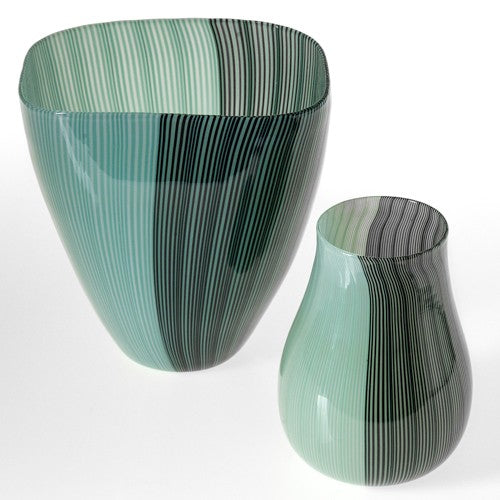Search
Categories
Archive
- September 2022
- February 2022
- September 2021
- May 2021

A glass invented by Carlo Scarpa for Venini & Co . during the late 30s. It is based on the traditional filigrana technique with particularly thin rods used...

A generally brownish-yellow colored glass, which over time has also been proposed in other shades (see in the picture a blue and brownish aventurine vase). It appears translucent, in which the m...

The pontèlo is a non-hollow rod used to finish the upper part of a blown artifact. Everything happens while the glass is at a temperature that makes the glass still deformable. Once ...

This is a glass rod executed with the same procedure as the murrina . A sheaf of cannas of different colours is prepared with a given design, then it is heated to the melting point: two metal r...

The blown glass technique dates back to the 2nd century BC.Previously, to obtain or containers, an incandescent glass wire was wound around a friable earthy core, smoothing and compacting the wire,...
Serventin is the one who takes the pea from the oven and prepare it for the Maestro

Literally cutter, big iron scissor. The tagliante is generally used to cut the edge of the blown glass. Its name and its shape are centuries old and it seems they will be the same for many other c...

The word probably derives from paciòn or da paciòso, which means chubby, bold: it is the pliers made like a fireplace caliper with rounded wooden rods. They are used to shape the surface of the gla...

The magnificent result of this technique is obtained by applying thin layers of colored glass to the work. The colored glass is blown and then placed in contact with the crystal at the appropriate ...

3d printing with glass. Where are we?
In the 800 years of history of glassmaking techniques in our marvelous island of Murano we never stopped in experimentation. In the last five years the 3D glass printing technique is evolving at g...

Springs or pliers similar to those of the fireplace, of various sizes and shapes. They are used to model hot glass. There are borsèle of different shapes depending on the work to be carried out, ...

The maestro is the main figure of the piazza . He is responsible of the overall perfection of each piece. The secrets of the composition of the siliceous sand, of the alum (Soda sand) are cherishe...

Literally blown cane in Murano is also called “fero sbuso”, “fero buxo”, or simply “fero”.It is a metal tube of variable size used to collect molten glass and then blow air inside the bolo , like...

Letterally round mould. It is a mould in which the glass is blown in order to have a repetitiveness of the shape. Usually the stampo has a round plan and opens in two pieces hinged along the c...

Mould like the Stampo a giro with the addition of a third element placed at the base in order to allow the base to be undercut. See also crecola . See also:...

Letterally Free mould. In this mold the glass is guided along predetermined directions, but left free to act independently. This is a series of blades that mark the limit of expansion of the glass...

The vetrofusione technique has been used starting from the 30's, it was initially used to create coloured glass windows or with reliefs. Subsequently, creations of centrepiece plates and other com...
